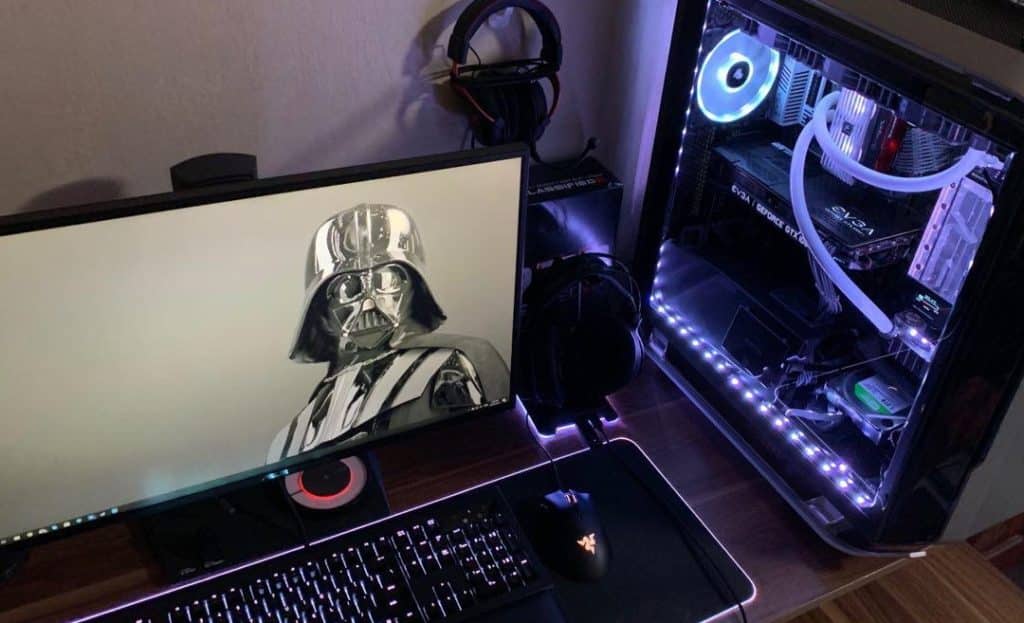
The Asus PG32UQXR offers high-end performance and features that you won’t easily find in its competitors. It’s a 4K 160Hz IPS monitor with a 576-zone 1000-nit backlight for substantially better HDR performance. It is more expensive than the typical 4K 144Hz+ offering, so let’s check it out to know if it’s a solid investment.
Asus ROG Swift PG32UQXR Specifications
- Screen Size: 32 Inches
- Resolution:3840 x 2160 UHD
- Aspect Ratio: 16:9
- Panel Technology: In-Plane Switching (IPS)
- Refresh Rate: 160Hz
- Response Time: 1ms
- Contrast Ratio: 1000:1
- Brightness: 400 cd/m2 (1000 cd/m2 Peak)
- Built-in Speakers: Yes (2 x 7 Watts)
- Stand: Height – Yes
- Stand: Tilt – Yes
- Stand: Swivel – Yes
- Stand: Pivot– No
- VESA Compatibility: Yes (100 x 100)
- Connectivity: DisplayPort 2.1 x 2, HDMI 2.1 x 4, USB 3.2 x 2, USB 2.0 x 1, 5mm Jack x 1
- Dimensions With Stand (WxHxD): 28.58 x 21.3″ x 10.98″
- Weight: 23.81 lbs
Design and Features
The Asus ROG Swift PG32UQXR looks identical to the PG32UQ, except for a few colored accents on the stand’s base. The monitor has a matte black finish which are decorated with orange-bronze accents and RGB lighting at the back. The screen has a bezel-free design on three sides, although it still has inner borders like most modern displays.

It’s larger than most monitors, so estimating your desk space before pulling the trigger is a must. The device is 28.58 inches wide and almost 11 inches deep, so it may displace some of your peripherals if your desk is smaller. It’s also quite heavy at 23.81 pounds, but the extra heft is understandable since it has a FALD unit inside.
Its build quality is fantastic, just like most of the brand’s offerings in the gaming segment. The plastics used are thick and sturdy, and there were no cosmetic defects of any sort. The included stand is firm and stable, so the large display won’t sag or shake in the middle of an intense gaming session.
The Asus ROG Swift PG32UQXR has an OSD joystick for easy access to its various settings and features. The gadget is located under the ROG logo on the bottom bezel, so it’s very easy to reach compared to the rear placement. Other monitors include remotes, but those are not necessary, and they can raise the price a bit.
The stand included with this model offers tilt, swivel, and height adjustments for your convenience. Pivoting wasn’t included, but that’s understandable since a monitor like this isn’t really meant for portrait or secondary display use. It’s compatible with VESA mounts, but it’s unnecessary unless you need more space or have a multi-display setup.
The connectivity layout of the Asus ROG Swift PG32UQXR is quite interesting since it includes modern standards. It has two slots each for DisplayPort 2.1 and HDMI 2.1 which allows it to avoid chroma subsampling. However, it doesn’t have USB-C, and its USB hub is quite limited, unlike the Acer X32 FP.
It doesn’t have speakers, but that’s okay since it deserves immersive headsets to maximize its potential. Asus often includes 2-watt pairs with their monitors, so it is not worth having them with a display like this.
Display and Performance
The Asus ROG Swift PG32UQXR boasts a 32-inch VA panel with a 3840 x 2160 resolution, a 160Hz refresh rate, and a 1ms boosted response time. The backlight has a 400 cd/m2 typical output and a 1000 cd/m2 peak, while the contrast is listed at 1000:1. This model has a 576-zone FALD backlight and HDR 1000 certification.
4K is more comfortable to use on larger screens since they aren’t too sharp for reading, typing, and browsing. The higher pixel count still makes images crisper, but you don’t have to use a lot of scaling to improve visibility and legibility. The real challenge with this monitor is getting high framerates, but it has become doable with today’s upper-tier GPUs.
The Asus ROG Swift PG32UQXR covers 100% sRGB and 96.5% DCI-P3 for rich colors in games and movies. Its default accuracy had a deltaE average of 2.78, which is quite high for a high-end monitor. However, gaming won’t be affected by this since the extra saturation is usually desirable for its intended users.
Calibrating it reduced the dE average to 0.61, making it comparable with most prosumer monitors. Doing this makes it suitable for editing work, but you will need a colorimeter to achieve similar results. Getting one is not worth it for gaming purposes, but users who are into color-critical work should get one.
The Asus ROG Swift PG32UQXR’s backlight reached 441 cd/2 in SDR, but it peaked at 1109 cd/mw when its HDR mode was active. Its contrast reached 1145:1, but it exponentially rose when the FALD backlight is working its magic. Only OLED models are better at this point, so this model doesn’t have a lot of competitors in this regard.
Panel uniformity for the test sample was excellent since there were no major backlight leaks on its edges. Clouding can happen when the mini-LEDs are transitioning, but it is not as bad as it used to be for monitors with lower local dimming zones. Note that this can still vary with every monitor made, so there are units with worse symptoms out there.
The Asus ROG Swift PG32UQXR barely shows any blurring since it is tuned quite well for fast-paced games. You need a bit of overdrive, but we don’t recommend maxing it out to avoid overshoot. It’s fantastic for games like Warzone, but it also works great with immersive titles that have excellent HDR implementations.
The Asus ROG Swift PG32UQXR is compatible with both FreeSync and G-Sync, unlike the older ROG Swift monitors. Compatibility is essential for a monitor like this since it will take a lot of GPU horsepower to utilize it. Its input lag sits at 4ms at 160Hz, so it’s as snappy and responsive as the best monitors out there.
Thoughts on the Asus ROG Swift PG32UQXR
The Asus ROG Swift PG32UQXR is an excellent example of what a premium gaming monitor should be. It offers fantastic image quality and HDR performance, thanks to its brilliant IPS panel and local dimming mini-LED combo. It’s solid and durable, plus it has essential features and modern connectivity, which basically makes it future-proof and a good investment.
However, it is going to be tough for this monitor in 2024 since 32-inch 4K OLEDs are coming out at around the same price. It also lacks some must-have features like USB-C, so practical users might go for its competitor instead. It’s a fantastic gaming display, but we can’t help but feel that it should be priced lower this year.
Pros:
- Rich Colors
- High Brightness and Local Dimming
- Great HDR and Gaming Performance
- Premium Quality
Cons:
- Expensive, but prices are coming down
- No USB-C or docking features/li>
2025 Update: Where the PG32UQXR Stands Today
The ASUS ROG Swift PG32UQXR remains a very strong contender in the 4K gaming-monitor space — but with a few caveats worth knowing now that we’re in late 2025.
Price & Value
As of October 2025, the street price has dropped significantly compared to its launch. You can find the PG32UQXR for around US $699 in certain deals. This makes the model a notably better value than at launch.
If you can pick it up near that price (or slightly higher), you’re getting excellent specs for the money. That said, if you still see it priced at US $900 or more, you might want to ask yourself whether that premium is still justified given newer alternatives.
Performance & Longevity in the Ecosystem
The PG32UQXR still delivers top-tier specifications: a 32″ panel at 4K (3840×2160) resolution, **160 Hz refresh**, 1 ms response time, a **576-zone mini-LED backlight**, peak brightness up to ~1,000 nits, and quantum-dot colour support with wide gamut. :contentReference[oaicite:1]{index=1}
However: the monitor market has progressed. In 2025 we are seeing 32″ 4K OLED or QD-OLED models that push refresh rates to 240 Hz or higher. So the question becomes: is the PG32UQXR still the *best choice* for your budget and needs?
- If you’re after premium HDR gaming, high refresh + 4K + strong picture quality with local dimming, then yes — it remains a top pick.
Recommended Use-Cases
You should seriously consider the PG32UQXR if:
- You have a **high-end GPU** (e.g., an RTX 40/50-series or equivalent) able to push 4K at high frame rates, and you’ll benefit from the 160 Hz refresh.
- You value immersive HDR gaming (single-player, story-rich titles) and strong picture quality (thanks to the mini-LED backlight and quantum-dot colour support). :contentReference[oaicite:2]{index=2}
- You have the desk space (32″, ~28.6″ wide panel) and a strong monitor stand or arm setup (the monitor is ~24 lb with stand) to accommodate it.
You might reconsider if:
- Your PC / GPU is older, or you game primarily at 1440p or 1080p — you may not take full advantage of 4K + 160 Hz, so you could save money by opting for a lower-tier monitor.
- You’re an esports/competitive gamer where ultra-high refresh/lowest latency dominate — then monitors that do 240 Hz (4K or QHD) or OLED may make more sense.
- You require USB-C with power-delivery, docking, or more productivity-oriented features — the PG32UQXR doesn’t lead in those connectivity areas.
Final Verdict
In 2025 the PG32UQXR has moved from “bleeding-edge premium” to “excellent high-end value,” especially if you buy it in the ~$700-800 range. It still offers best-in-class specs for many high-end gamers. That said, if you’re buying new and want future-proofing beyond what it offers (for instance, 240 Hz+ 4K OLED) then it’s wise to compare with the newer entrants before committing.
If you already have it, you’re still in a very strong place. If you’re buying now, just make sure you’re buying with eyes open about the trade-offs (and price) relative to newer models.
About the Author:

 Paolo has been a gaming veteran since the golden days of Doom and Warcraft and has been building gaming systems for family, friends, and colleagues since junior high. High-performance monitors are one of his fixations; he believes that every citizen’s right to enjoy one. He has gone through several pieces of hardware in pursuit of every bit of performance gain, much to the dismay of his wallet. He now works with Monitornerds to scrutinize the latest gear to create reviews that accentuate the seldom explained aspects of a PC monitor.
Paolo has been a gaming veteran since the golden days of Doom and Warcraft and has been building gaming systems for family, friends, and colleagues since junior high. High-performance monitors are one of his fixations; he believes that every citizen’s right to enjoy one. He has gone through several pieces of hardware in pursuit of every bit of performance gain, much to the dismay of his wallet. He now works with Monitornerds to scrutinize the latest gear to create reviews that accentuate the seldom explained aspects of a PC monitor.


Leave a Reply